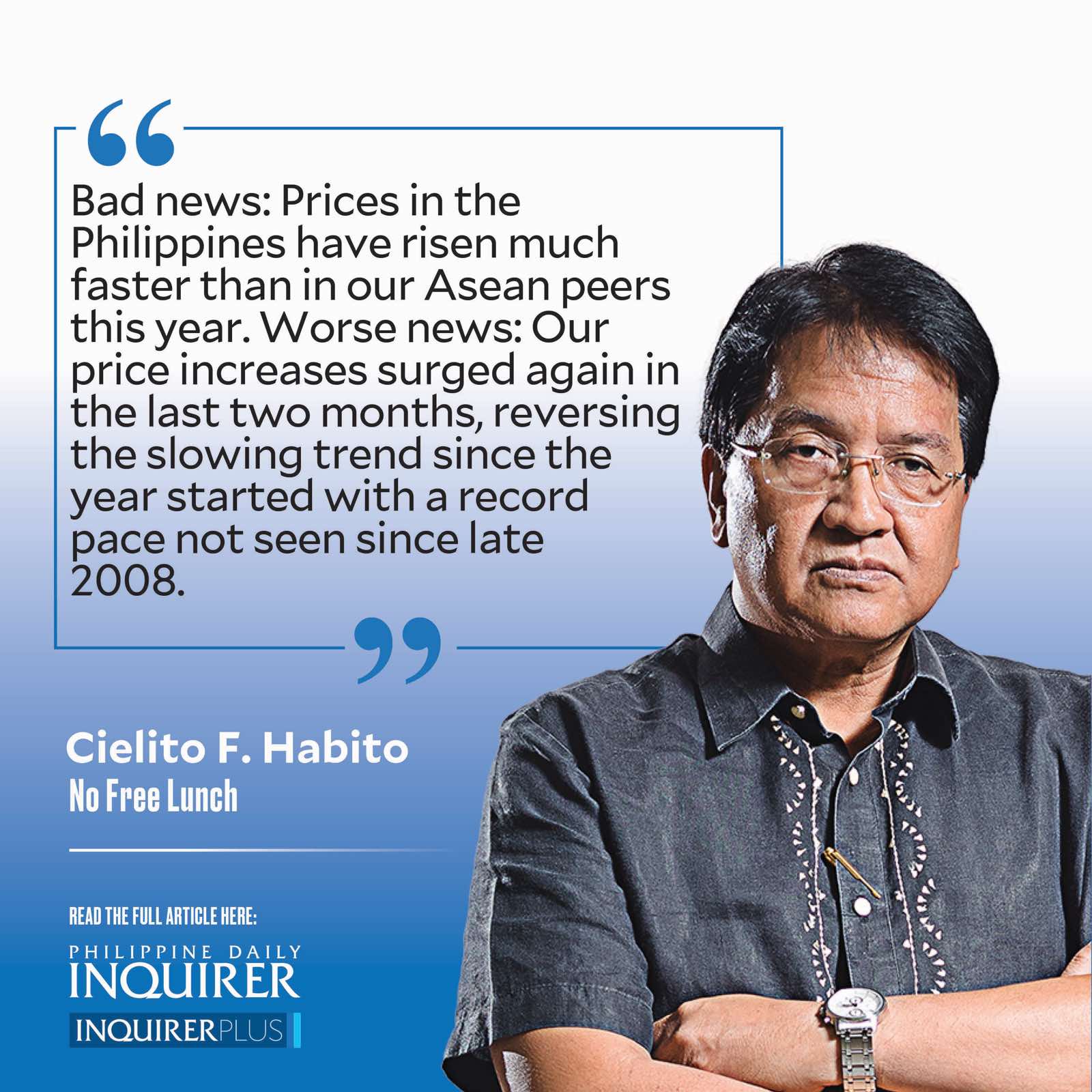Dissecting our inflation

Bad news: Prices in the Philippines have risen much faster than in our Asean peers this year. Worse news: Our price increases surged again in the last two months, reversing the slowing trend since the year started with a record pace not seen since late 2008. In numerical terms, our inflation rate had again risen to 5.3 and 6.1 percent in August and September, respectively, reversing a steady decline since its 14-year peak of 8.7 percent in January that bottomed out in July at 4.7 percent.
In contrast, inflation in our Asean-6 peers Thailand, Malaysia, Indonesia, and Vietnam slowed down last month, from rates already much slower than ours. While Singapore nudged up to 4.1 percent from 4.0 percent in August, that’s still much lower than ours. Our somewhat unique inflation picture prompted the Bangko Sentral ng Pilipinas (BSP) to make the surprise off-cycle move last week of finally raising its policy interest rate from 6.25 to 6.5 percent, after holding steady since April. Through that period, BSP was under constant pressure to raise it because the United States Federal Reserve Bank had already raised its rate twice (from 5.0 to 5.25, then 5.5 percent). And when the BSP doesn’t follow the US Fed’s rate hikes, many worry about dollars being withdrawn out of our economy to flow back into the US, attracted by higher yields. This depresses the value of the peso (or raises the peso-dollar exchange rate). But the BSP’s primary mandate is to manage inflation, not so much the exchange rate unless its movement also begins to drive inflation. So with the recent peso decline accompanying resurging inflation, the sudden change of heart at the BSP is no big surprise.
Even so, I know that finally raising interest rates further was not an easy decision for the BSP to make. Interest rate setting is like walking a tightrope because there’s usually a tradeoff between price stability and economic growth (and with it, jobs). The latest rate hike worries our other economic managers who fear its growth-stifling effects at a time when economic activities are faltering, evidenced by the worse-than-expected GDP growth slowdown in the second quarter. The third quarter is over and the numbers won’t be in until later in November, but the data on advance indicators such as volume of manufacturing output, electricity consumption, building permits, and investment approvals don’t paint an encouraging picture. At the same time, doubts are being raised, including by Socioeconomic Planning Secretary Arsenio Balisacan, on how well further interest rate hikes could quell our resurging inflation without generally choking the overall economy.
A closer examination of what drives our inflation makes it easier to understand Balisacan’s skepticism. Since last year’s inflation upsurge, food prices have been its primary driver. Last month, food prices rose 10 percent against the same month last year, up from the 8.2 percent posted in August. Rice was the main culprit, with price rising 17.9 percent, double the 8.7 percent rise in August. According to the Philippine Statistics Authority, 61 percent of the 6.1 percent overall inflation rate, or 3.7 percentage points, traced to food and non-alcoholic beverages; food alone accounted for 3.6 percentage points. Restaurants and hotels contributed 11.4 percent share or 0.7 percentage point, while housing, water, electricity, gas, and other fuels had an 8.6 percent share or 0.5 percentage point. Note that the higher costs of restaurants also traced mainly to higher food costs, while externally driven energy cost hikes prominently drove cost increases in hotels, housing, and utilities. And interest rates have little to do with these.
Both BSP Governor Eli Remolona and his predecessor Felipe Medalla have both publicly expressed discomfort at having to use the demand-side tools at the BSP’s disposal to address an inflation problem clearly caused by supply-side shortcomings. The outspoken Medalla had even chided the Department of Agriculture (DA) for failing on its task to ease supplies (hence prices) of food commodities, especially as it insisted on continued tight regulation of imports when domestic supplies were very tight—after having failed on its basic goal to raise productivity and cost competitiveness of our farms and farmers over past decades.
The DA must finally get its act together if we are to spare the BSP from having to keep using the shotgun policy of interest rate hikes to quell inflation, inflicting a lot of collateral damage on the rest of the economy as it does, with the poor always the worst hit. It must start with fundamental restructuring and reorganization of the DA bureaucracy and budget, along with a major shakedown to rid it of the unwanted elements that have traditionally stood in the way of needed reform.
—————-
cielito.habito@gmail.com




















